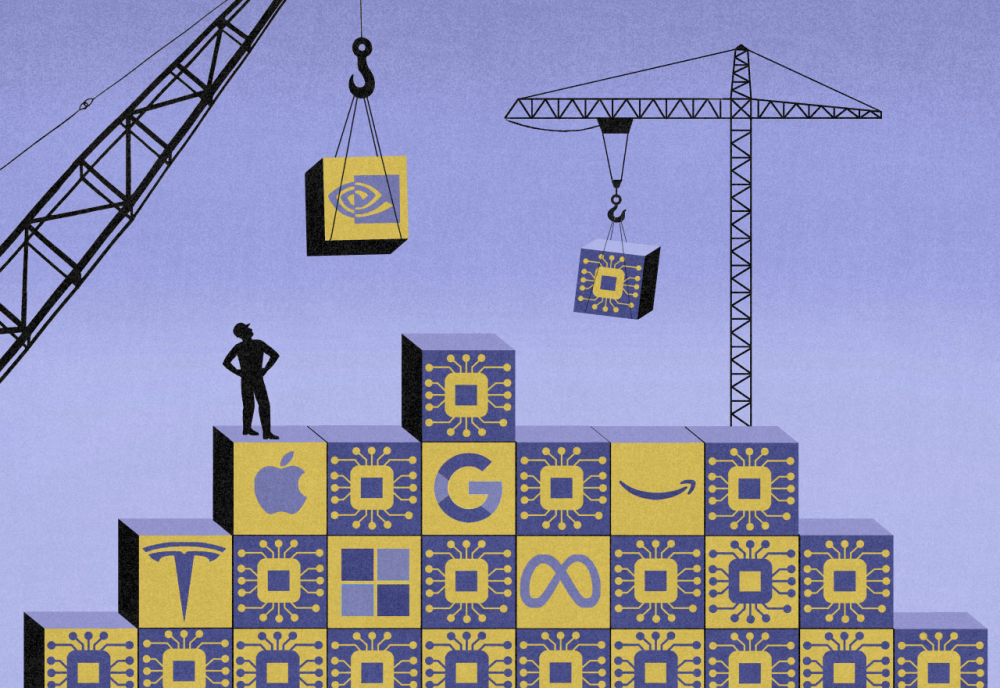James Steinberg
There’s a point in every technological cycle when engineers and inventors are rapidly innovating. The spoils go to those who “move fast and break things,” to quote 2010s-era Mark Zuckerberg.
We’re now entering a phase in which the giants win because they own, and continue to build out, the physical assets that make mature technologies accessible.
Call it an “age of infrastructure,” in which
companies spend vast sums on actual
stuff. Primarily that’s the gigantic data centers filled with tiny chips, and everything that connects and cools them, but it also includes factories, real estate and energy.
It’s reminiscent of the age of business titans and “robber barons” who dominated railroads, steel and other enterprises. And as happened then, today’s massive companies, with their ability to spend (and borrow), are making their moats even deeper and wider. Even formidable competitors, such as OpenAI, are hard-pressed to keep up.
A look at one key line item in company earnings reports—capital expenditures—shows that the most valuable tech companies are buying and building stuff at a record pace. The Magnificent 7 tech firms have collectively spent a record $102.5 billion on capex in their most recent quarters, nearly all from Meta, Alphabet (Google), Microsoft and Amazon. (Apple, Nvidia and Tesla together contributed a mere $6.7 billion.)
Investor and tech pundit Paul Kedrosky says that, as a percentage of gross domestic product, spending on AI infrastructure has already exceeded spending on telecom and internet infrastructure from the dot-com boom—and it’s still growing. He also argues that one explanation for the U.S. economy’s ongoing strength, despite tariffs, is that spending on IT infrastructure is so big that it’s acting as a sort of
private-sector stimulus program.
Capex spending for AI
contributed more to growth in the U.S. economy in the past two quarters than
all of consumer spending, says Neil Dutta, head of economic research at Renaissance Macro Research, citing data from the Bureau of Economic Analysis.
A global accounting of this infrastructure spending would be even bigger, as it would include capex from these companies’ most important partners. Foxconn has recently spent big building out factories for Apple in India, which just supplanted China as the source of the majority of U.S.-destined iPhones,
according to Canalys. And the world’s largest chip manufacturer, TSMC, spent about $10 billion on capex in its most recent quarter.
In the not-too-distant past, when Facebook, Microsoft and its competitors mostly produced code, salary and stock compensation was a much bigger proportion of their spending. For these companies to continue growing, they are now vertically integrating and owning more of what it takes to run their businesses.
Construction on the first phase of Microsoft’s $3.3 billion data center in Mount Pleasant, Wis., is expected to be completed in 2026.
This hasn’t exactly happened overnight, says Patrick Moorhead, an industry analyst, who calls what’s happening now “planet-scale infrastructure.”
Back in 2003, when Moorhead was an executive at AMD, his company sold Google some of its earliest systems for building out its data-center infrastructure as cheaply as possible. What had been expensive boxes—basically PCs on steroids—at the beginning of this century evolved in two decades into vast arrays of rack servers that facilitate today’s internet and the explosive growth of AI supercomputers. All of this IT infrastructure and its support systems are our generation’s railroads and steel mills, he adds.
OpenAI, arguably the most well funded startup, still has difficulty competing with the giants. It depends on continuous and gigantic infusions of investor cash, even as the fast-following big-tech companies peel off its customers and talent. OpenAI has struggled recently to realize its dream of a
gigantic AI data center called Stargate, and Meta has lured away some of its engineers with eye-watering
pay packages.
Meanwhile, Apple and Nvidia spend less on capex but direct huge contracts for chips and manufacturing to partners, so they’re able to monopolize the attention and output of those partners. And Tesla is historically no slouch, known for spending big on factories, a charging network, even mining operations.
In an almost too-perfect parallel to the bygone age of John D. Rockefeller, Andrew Carnegie and J.P. Morgan, some of today’s power-hungry data centers are actually being put on the sites of
former steel mills, because of their proximity to energy sources.
It’s important not to take these comparisons too far, cautions H.W. Brands, a professor of history at the University of Texas at Austin and an authority on the
late 19th century titans of industry. One difference: While they might spend big on infrastructure, today’s most valuable companies are lightly staffed. “The striking thing about these companies is compared with their wealth, how few people they employ,” he adds.
An area where we can draw a strong parallel, says Brands, is in antitrust enforcement: Now, as then, it only tends to happen long after companies reach their peak size and power. In terms of competition, there are hardly any signs these companies will be disrupted anytime soon, says Moorhead.
In addition to their record capex spending, many big tech companies are also engaged in an all-out war for certain kinds of talent, particularly in AI—railroads need engineers. Hundreds of millions of dollars are changing hands in “acqui-hires” and talent poaching. This war for talent is becoming yet another way that advantages accrue to the biggest tech companies with the deepest pockets.
The lesson in all this: When there isn’t much regulation, and competition is limited to a handful of coexisting hegemons, the biggest threats come from overseas. The U.S. and China are, of course, locked in a contest for global industrial dominance. America once had an easy lead—but its continuing success is
no longer guaranteed.





